In today's digital landscape, mastering the art of effective advertising is crucial for e-commerce businesses seeking to thrive. One powerful avenue to explore is the realm of Product Listing Ads (PLAs), which can elevate your products to a broader audience, driving sales and growth.
This comprehensive guide will delve into Product Listing Ads, exploring their intricacies on platforms like Google, Bing, Facebook, and Amazon.
What are Product Listing Ads?
Product Listing Ads, often called PLAs, are a dynamic form of advertising that revolves around showcasing your products visually, engaging and informatively. Operating on a cost-per-click (CPC) model, these ads appear across various platforms, each with its unique touch. The beauty of PLAs lies in their ability to deliver text-based information and an entire snapshot of your product, complete with imagery and essential details.
In digital marketing, you might come across various names and abbreviations that allude to Product Listing Ads. While we'll be diving deeper into the specifics in a separate post, here's a snapshot of the fundamental aspects:
- Google Product Listings: These ads are known on Google properties, including Search, Shopping, and images.
- Bing Product Listings: Similarly, Bing Shopping allows your products to shine on their properties, Search, Shopping and images.
- Facebook Product Listings: The social media giant also offers a stage for product ads to capture the attention of potential customers.
- Amazon Product Listings: The e-commerce behemoth is a playground for your products to thrive.
But what truly sets PLAs apart is their composition. Unlike traditional text ads that you might encounter in Google and Bing Search, Product Listing Ads are meticulously crafted using your product data. This data, comprising vital elements such as product title, description, images, and price, presents a holistic view of your offering.
Creating these compelling ads doesn't occur by chance; it results from strategic campaign planning. Advertisers utilise product data to generate PLAs, ensuring they align with campaign objectives and resonate with the target audience.
The following sections will delve into the mechanics of crafting effective PLAs.
What Are The Benefits Of Product Listing Ads?
Harnessing the power of Product Listing Ads (PLAs) can significantly transform the trajectory of your retail business. Whether you're a novice in digital advertising or a seasoned marketing expert, PLAs offer various benefits to bolster your brand's presence and enhance your growth prospects.
Expanding Reach and Growth: Shopping ads are a versatile tool that can catalyse your business's expansion, regardless of your expertise level. Whether you're just stepping into digital advertising or have been navigating it for years, PLAs provide a platform to propel your brand's reach and growth.
Enhanced Product Visibility: One of the standout features of Product Listing Ads is their ability to amplify your product's visibility. These ads don't merely appear as text on a search results page; they present your product thoroughly, with compelling imagery and essential information. This visual showcase captivates potential customers, enticing them to explore further.
Leveraging Buyer Intent: In platforms like Google and Bing, where search queries are fueled by buyer intent, Product Listing Ads have a unique advantage. They position your products precisely where potential customers are actively seeking solutions. This alignment between user intent and your offerings increases the likelihood of sale conversions.
Precise Prequalification: The beauty of PLAs lies in their ability to offer a sneak peek into your product before a click-through occurs. Potential customers can directly assess the product's title, image, and price from the search results. This prequalification process ensures that those who click through are genuinely interested.
Real-Time Dynamic Data Feeds: Many PLAs are powered by dynamic product feeds from popular e-commerce platforms like Shopify and WooCommerce. This synchronisation ensures that your product ads reflect the latest pricing, offers, and availability in real-time. Notably, out-of-stock products are automatically excluded, ensuring ad spend efficiency.
Global Reach Control: With PLAs, you can decide whether to showcase your products globally or target specific countries. This level of control empowers you to tailor your campaigns to regions where your offerings are likely to resonate the most, optimising your reach and impact.
As we've seen, Product Listing Ads encompass a spectrum of advantages that can propel your e-commerce business forward.
Product Listing Ad Platforms
As we journey deeper into the realm of Product Listing Ads (PLAs), it's essential to grasp the PLA platforms that host these captivating campaigns. Each platform comes with its unique attributes, offering retail businesses diverse avenues to connect with their target audience.
This section will explore the world of Google Product Listing Ads, their appearance, assembly, and how to get started.
Google Product Listing Ads
Where Google Product Listing Ads Are Shown
Google Product Listing Ads radiate across several vital spaces within the Google ecosystem. They appear in Google's Search Engine, Shopping Results, and Image Search. These ads are triggered by keywords users input, making them intimately aligned with user intent.
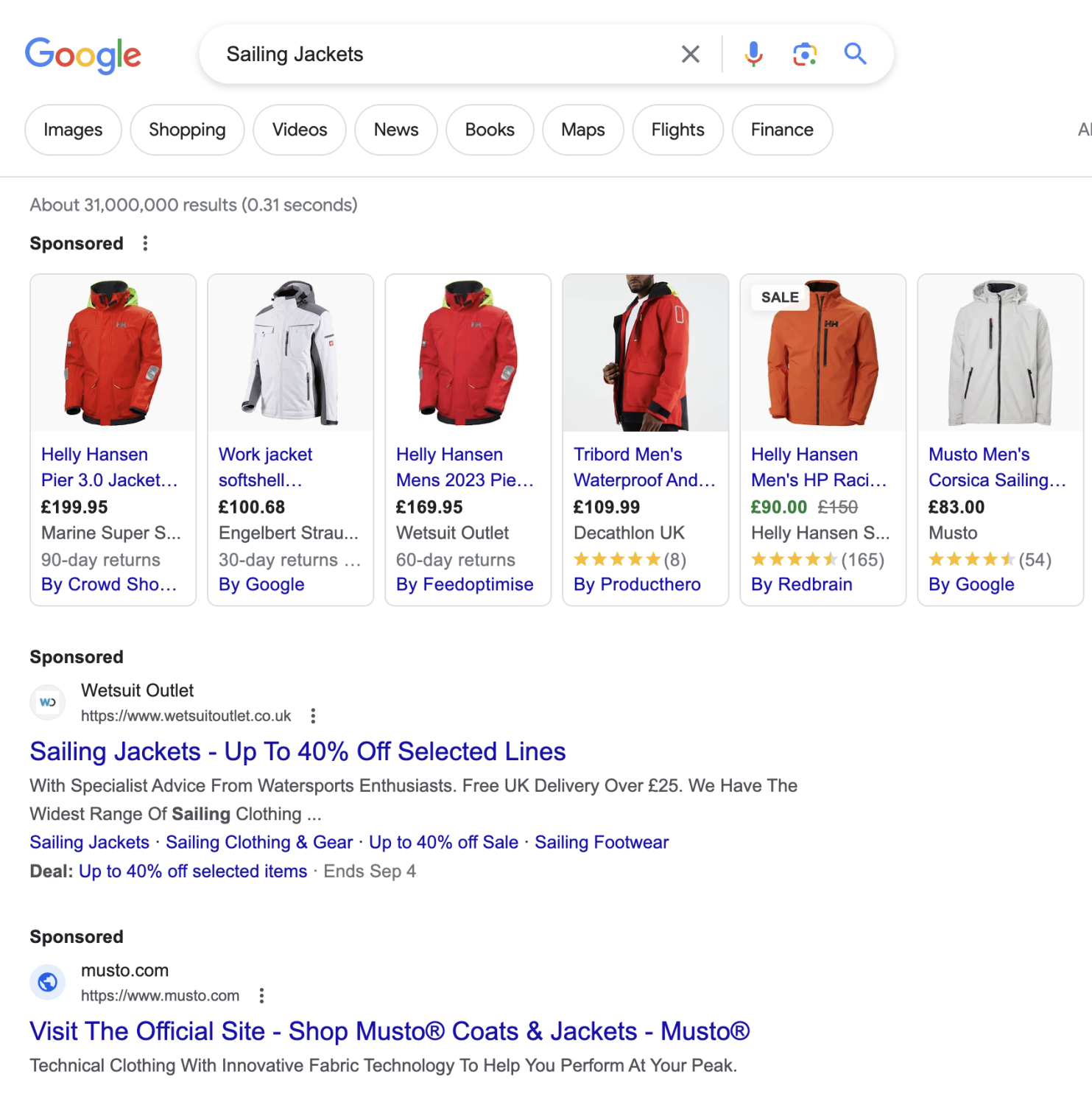
What Do Google Product Listing Ads Look Like?
Picture this: a potential customer searches for a product, and voilà! They're greeted by a carousel of enticing images showcasing products that match their query. These visual ads are vibrant, captivating, and loaded with essential information.
Here is an example of how Google Product Ads look in the Google Search results;
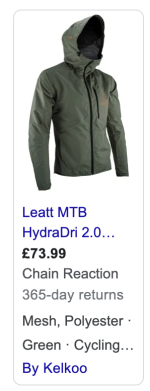
An example of a Product Ad in the Google Shopping tab;
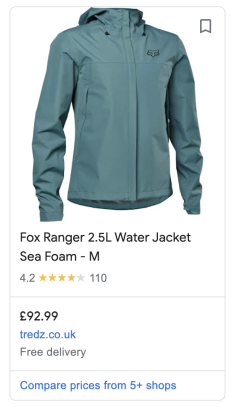
An example of a product listing ad in a Google image search;
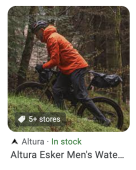
How Google Puts Product Listing Ads Together
Behind these eye-catching ads lies a sophisticated process. To craft these ads, Google uses a data feed, a structured list of product details.
Ensuring your data feed is well-optimised is critical to delivering relevant ads to your customers. This involves enriching your data feed with colour, size, materials, and other details about your product's features and benefits.
What Google Campaign Types Support Product Ads
When it comes to campaign types that support Product Listing Ads on Google, two prominent options stand out:
- Google Shopping Campaigns: These campaigns are specifically tailored for Product Listing Ads and find placement in Google Search Results, Shopping Results, and Images. They provide a direct route to showcasing your products to potential customers in various Google spaces.
- Google Performance Max Campaigns: If automation and comprehensive reach are what you seek, Performance Max Campaigns might be your choice. In addition to leveraging machine learning, these campaigns extend beyond Product Listing Ads, encompassing Search Ads and Display Ads across Google's expansive network.
For a detailed comparison between Standard Shopping and Performance Max campaigns, check out our blog post: Unveiling the Duel: Google Performance Max vs Standard Shopping Campaigns.
How To Get Started With Google Product Ads
Embarking on your Google Product Ads journey requires some foundational steps:
- 1. Set Up Google Merchant Center: Before delving into ad creation, you'll need a Google Merchant Center account linked to your organisation's Google account. This is where your product data resides. If you need guidance on this, we have another post, What is Google Merchant Center: A Retailer's Essential Guide to Getting Started.
- 2. Import Your Product Data: Your Google Merchant Center account is the hub where you import your product data. This involves connecting your product feed or leveraging platform APIs from e-commerce systems like Shopify or WooCommerce.
- 3. Link Google Ads & Merchant Center Accounts: A Google Ads account is essential for campaign creation. Link it to your Google Merchant Center account to synchronise your product data seamlessly. Only when your Ads account can access your product data you will be able to create a Google Product Listing Campaign.
- 4. Define Your Strategy: Decide on an advertising budget and define your objectives, whether achieving a specific cost per sale or return on ad spend. These parameters guide your strategy.
- 5. Utilise Product Groups: Use product groups strategically to manage and optimise your campaigns. You can exclude items with low profit margins, promote specific collections, or split budgets proportionally among profitable product groups.
- 6. Set Up Conversion Tracking: Google Conversion Tracking is crucial for monitoring sales and adjusting bidding strategies based on actual sales data.
- 7. Choose Your Campaign Type: With your Google Merchant Center and Google Ads accounts linked, you'll decide whether to opt for the control of a Standard Shopping Campaign or embrace the automation of Performance Max.
To explore a comprehensive guide on getting started with Performance Max campaigns, check out our blog post: A Beginner's Guide to Google Performance Max: Retail Success Made Easy.
Next, let's delve into Bing Shopping Ads, another platform with immense potential for your Product Listing Ads strategy.
Bing Shopping Ads: Expanding Your Product Reach
As we explore the landscape of Product Listing Ads (PLAs), another powerful platform comes into view: Bing Product Ads. With its unique features and reach, Bing offers e-commerce businesses an exceptional opportunity to connect with a broader audience. This section will explore what Bing Shopping Ads offer, their distinctive appearance, and how you can embark on this journey.

Free Report
Spot Errors, See Strategies,
Our Free Report Reveals Key E-Commerce Fixes.
Book Your Call
What Are Bing Shopping Ads?
Like Google Product Listing Ads, Bing Shopping Ads provide a visually enticing way to showcase your products to potential customers. These ads appear within Bing's search engine, allowing you to tap into an alternative user base and extend your reach beyond Google's ecosystem.
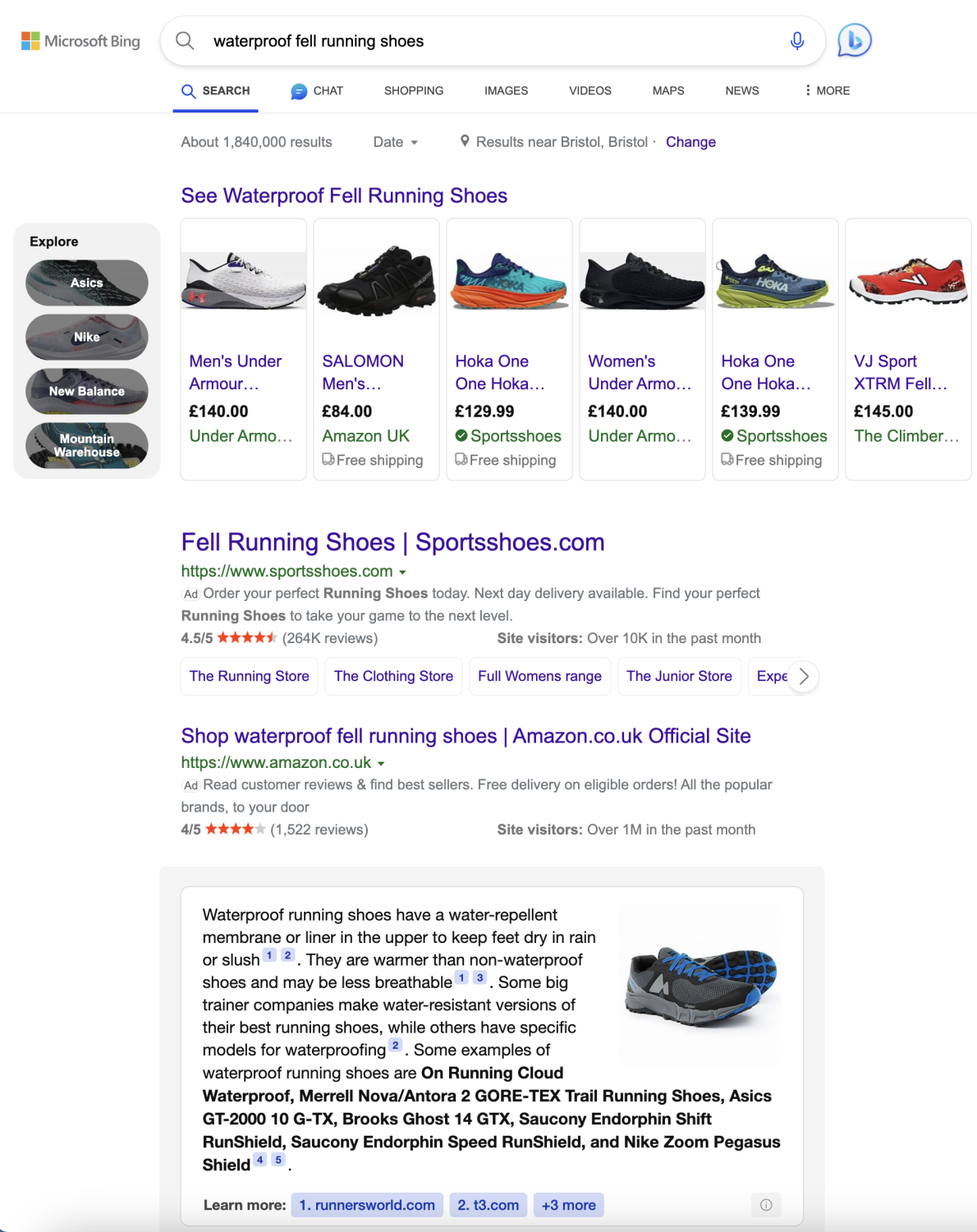
What Do Bing Shopping Ads Look Like?
While searching online in the Bings search engine, alongside the traditional text-based search ads, users are presented with a gallery of eye-catching product images. These images are accompanied by essential details such as product title, price, and retailer information. This visual representation enhances the customer's understanding of your product before they click.
Here is an example of a Bing Product Listing Ad;
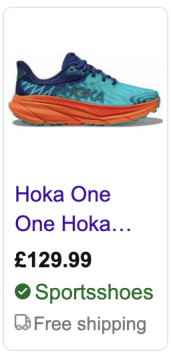
An example of a Bing Product Ad in the Shopping results;
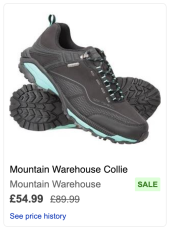
An example of a Bing Product Ad in the image search results;
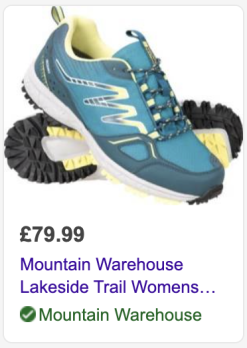
How Does Bing Put It's Product Listing Ads Together?
Creating Bing Shopping Ads involves harnessing the power of a well-structured data feed. Just like with Google Product Listing Ads, the quality of your data feed plays a pivotal role in the effectiveness of your ads. Ensuring your product data is accurate, comprehensive, and up-to-date is crucial.
Your data feed is added via Bing's Merchant Center, where it's validated, and any errors are reported. Then, your Bing Shopping campaigns pull the product data from here to form your Shopping ads.
So, as your ad content is driven by the quality of content in your product data feed, it's essential to enrich your data feed with colour, size, materials, and other details that communicate your product's features and benefits.
What Bing Campaigns Support Product Ads?
When it comes to Bing, two primary campaign types support Product Listing Ads:
- Bing Shopping Campaigns: These are similar to Google's standard Shopping Campaigns, where you create a campaign and ad group structure, choose which products to include and exclude, set your bidding and apply negative keywords for search filters. They are tailored specifically for Product Listing Ads within Bing's search results. Leveraging these campaigns helps you capture the attention of users searching on Bing.
- Bing Smart Shopping Campaigns: These are the choice campaigns if you are looking for a more automated option. They deliver shopping ads similar to the above campaign but draw on Bing's AI systems to manage the campaign for you regarding bidding, scheduling, and search query targeting.
It's essential to be aware that in the case of Smart Shopping campaigns, these offer less control and no visibility of search queries, and the success of these campaigns is at the mercy of whether Bing can figure out an appropriate bid strategy for you. Accounts with small budgets or low search volumes due to small product catalogues or niche categories may be challenging for this system to optimise, and a standard campaign will be better suited.
Getting Started With Bing Shopping Ads
Embarking on your journey with Bing Shopping Ads involves a few essential steps:
- 1. Set Up a Microsoft Advertising Account: A Bing Ads account is where you'll manage your ad campaigns, but this is the first step as it's from here: you'll create your Bing Merchant Center account.
- 2. Set Up a Microsoft Merchant Center Account: Like Google's Merchant Center, Microsoft offers its Merchant Center. This is where you'll manage your product data. However, unlike Google, the Merchant Center is accessed from within your Bing Ads account.
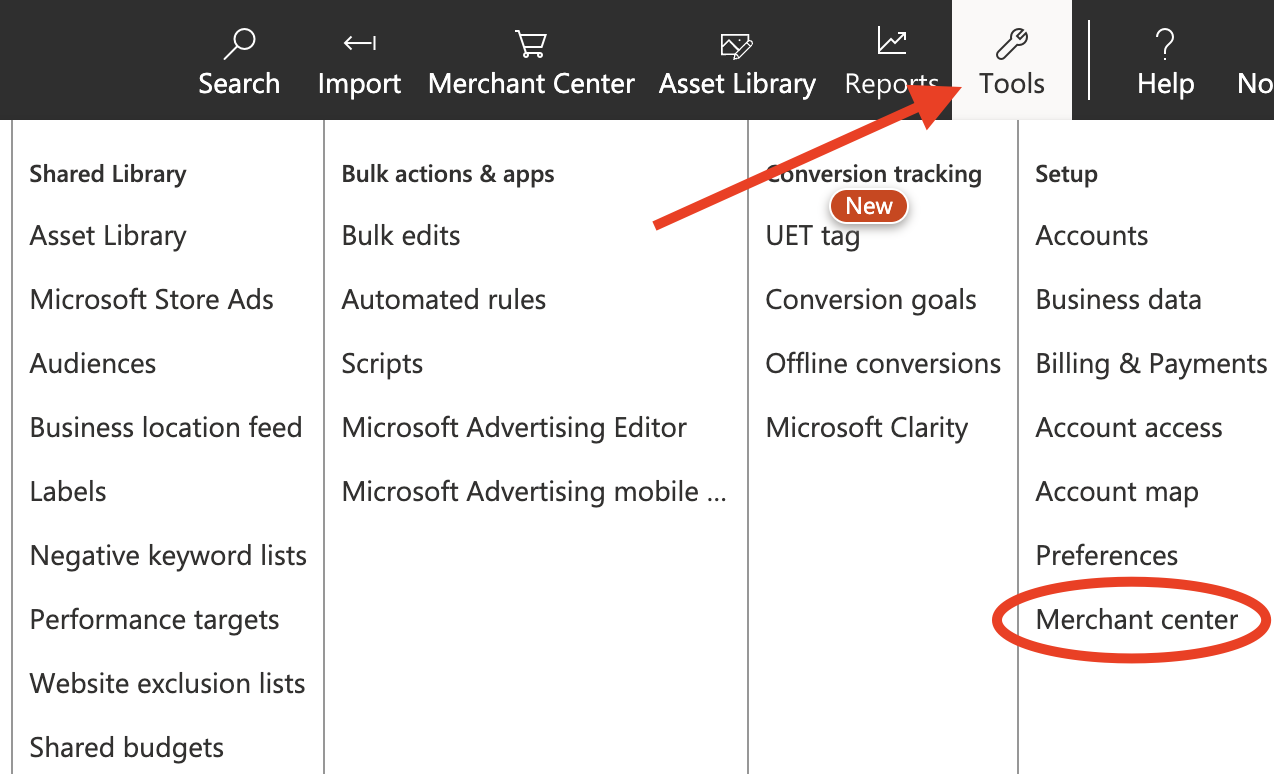
-
3. Import Your Product Data: With the above in place, you can import your product data into the Microsoft Merchant Center. Like with Google, there are options for how this is imported. You can add an XML feed or one of the simplest ways, and if you are already operating Google Shopping campaigns, connect Bing Merchant Center with Google Merchant Center and import your product data from there.
Alternatively, Shopify offers an app for directly importing product data from your Shopify Store to Bing Merchant Center with your Bing Shopping app for Shopify.
-
4. Define Your Strategy: Determine your advertising budget and objectives, ensuring alignment with your business goals. This is an essential step before you begin creating your campaigns.
-
5. Utilise Campaign Types of PLAs: Choose Bing Standard Shopping Campaigns for targeted search result ads or Bing Smart Shopping for a more automated option.
With your Bing Shopping Ads strategy, you're primed to tap into a new realm of potential customers and extend your e-commerce presence.
Facebook Product Ads: Expanding Retail Possibilities
In our exploration of Product Listing Ads, we must recognise the dynamic world of Facebook Product Ads, also known as catalogue ads. These ads open up a spectrum of advertising possibilities for retailers, intertwining the power of social media and product promotion.
Let's delve into what Facebook Product Ads offer, where they appear, their appearance, and how you can embark on this avenue.
What Are Facebook Product Ads?
Facebook Product Ads, referred to as catalogue ads, empower businesses to showcase their products engagingly. When creating ads on Facebook, 'catalogue ads' is the format option that brings your products to life. With Meta Product Ads, you can highlight different products, ensuring your offerings resonate with your target audience.
For more details, check out Facebook Ads - Product Ads.
Where Are Facebook Product Ads Shown?
The reach of Meta Product Ads extends across various spaces, both within and beyond Facebook's domain. Depending on your advertising objective, these ads can appear in different contexts:
- Facebook: Product ads grace users' feeds, Marketplace, Groups, and the right column. They also find placement in Instant Articles, search results, and video feeds.
- Instagram: The allure of Facebook Product Ads extends to Instagram feeds and Stories.
- Messenger: These ads appear as sponsored messages, allowing for personalised engagement.
- Audience Network: Meta Product Ads transcend Facebook's platforms, appearing within apps and websites that are part of the Facebook Audience Network.
What Do Facebook Product Ads Look Like?
As users scroll through their Facebook or Instagram feeds, Amid the posts, they'll encounter captivating images showcasing products, accompanied by their titles and descriptions. Facebook Product Ads mirror the essence of product ads we discussed earlier, offering potential customers an enticing preview of your offerings.
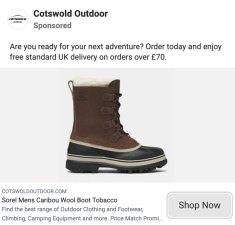
However, Facebook Product ads are more flexible than the product ads discussed above, offering room for a little more creativity, as we'll cover next.
How Does Facebook Put Product Ads Together?
Creating Facebook Product Ads introduces a layer of flexibility that sets them apart. These ads offer more creative freedom than the formats provided by Google and Bing Shopping Ads. While product images remain fixed, the product data can be dynamically pulled in and positioned wherever needed within the ad. This flexibility extends to ad copy, allowing advertisers to craft messages tailored to their target audience.
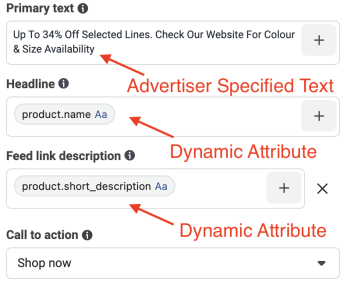
The integration of manual content and dynamic product data offers unparalleled control. Advertisers can strategically choose products for specific campaigns, promoting sales or seasonal offerings. Product attributes are drawn from Facebook Commerce Manager, where product attributes are held.
What Facebook Campaigns Support Product Ads?
The canvas for Facebook Product Ads is expansive. Any Facebook campaign can support Product Ads, provided the creative type is set to 'catalogue'. This connection enables advertisers to link their ads to product catalogues or specific product sets configured within Facebook Commerce Manager.
The versatility of targeting options within Facebook ads allows for precision:
- - Reach people who visited your website.
- - Target individuals based on specific interests or locations.
- - Showcase products viewed on your website.
- - Utilise customer matching to tailor ads to particular customer groups.
The possibilities are endless, driven by the diversity of Facebook's audience targeting capabilities.
How To Get Started With Facebook Product Ads
Embarking on your Facebook Product Ads journey involves a few fundamental steps:
- 1. Set Up Facebook Commerce Manager: First, add your product catalogue to Facebook Commerce Manager.
- 2. Import Your Product Data: Importing your product data can be done manually through the Commerce Manager interface. Alternatively, you can synchronise your product data with your website using a data feed.
- 3. Craft Your Campaign: Define your goals, objectives, and targeting criteria. Design your ads as 'catalogue ads' to leverage your product data.
With these foundational steps in place, you're poised to harness the power of Facebook Product Ads, connecting your products with a broader audience through social media.

Getting Started With
Performance Max
Download Our Step-by-step guide to getting started with Performance Max Shopping Campaigns for your Shopify Store
GET YOUR FREE EBOOKFREE EBOOK
Amazon Sponsored Product Ads: Elevating Product Visibility
In the world of e-commerce, Amazon stands as a titan, and its Sponsored Product Ads offer retailers a pathway to enhance their product visibility within this bustling marketplace. These ads, essentially sponsored product listings, leverage Amazon's immense reach to connect your offerings with potential buyers.
Let's delve into Amazon Sponsored Product Ads' essence, appearance, and how to embark on this journey.
What Are Amazon Sponsored Product Ads?
Amazon-sponsored product Ads epitomise cost-per-click (CPC) ads designed to amplify individual product listings' exposure on the Amazon platform. These ads are strategically positioned to catch the eyes of Amazon shoppers actively searching or browsing for relevant keywords or products.
When shoppers click the ad, they're transported to the product's detailed listing page. This heightened visibility improves your product's presence and drives potential sales, ensuring that your offerings don't remain hidden within the labyrinth of Amazon's vast catalogue.
What Do Amazon Sponsored Listings Look Like?
As Amazon shoppers search for products, they encounter a listing with the "sponsored" indicator amidst the results. Amazon-sponsored listings sport a familiar appearance, blending seamlessly into various product listings. However, this subtle differentiation serves a potent purpose: boosting the visibility of products within Amazon's product search results.
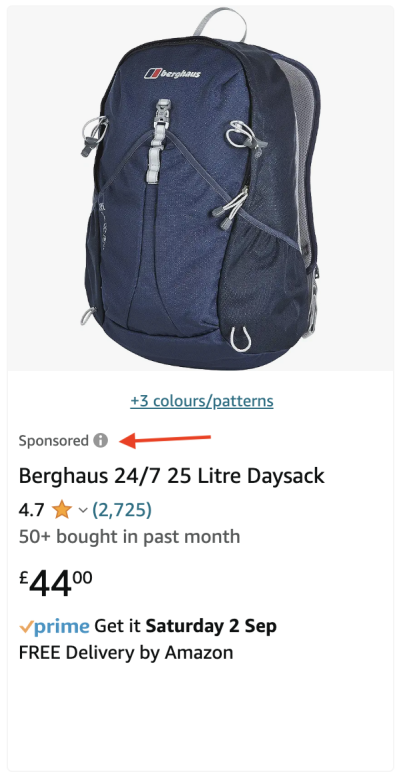
Where Do Amazon Sponsored Product Listings Appear?
The reach of Amazon Sponsored Product Listings extends across pivotal spaces within the Amazon website. These ads can appear at the top, alongside, or within search results. They also find placement on product pages, offering a comprehensive spectrum of touchpoints where potential buyers can encounter your offerings. Just like other Product Ads, optimisation is critical—your product data must resonate with the relevant keywords that Amazon shoppers use.
How To Get Started With Amazon Sponsored Listing Ads
Embarking on your Amazon Sponsored Product Ads venture is straightforward:
- 1. Have an Amazon Store with Listed Products: To promote your products, you must first have an Amazon store with the products you wish to highlight.
- 2. Create a Campaign: Start by crafting a new campaign in Amazon Ads. Define the campaign's duration and set a daily budget. Your budget can be set at both the account and campaign levels.
- 3. Targeting Decisions: Decide whether to target specific keywords or products or opt for automatic targeting, letting Amazon match your ads to relevant search terms and products. Unlike Google and Bing Shopping, Amazon Sponsored Product Ads offer the flexibility to specify the keywords you want your products to be associated with.
- 4. Select Promoted Products and Set Bids: Choose the products you want to promote within the campaign. Set your bids, determining the amount you'll pay for each click your ad garners.
With these foundational steps in place, your products are poised to traverse the vibrant avenues of Amazon's marketplace, ensuring their presence is felt by eager shoppers.
Key Elements of Successful Product Listing Ads & Best Practices
Navigating the realm of Product Listing Ads requires a strategic approach, leveraging essential practices to ensure optimal performance. As you embark on this journey, here are some best practices to consider:
Keeping Your Product Data Up To Date
Synchronising your product data between your website and advertising platforms offers various benefits. This practice ensures your data's accuracy, safeguarding against discrepancies between advertised and actual prices on your website. Maintaining accurate stock information also prevents ads being served for out-of-stock products, preserving your advertising budget for in-stock items.
Implementing an XML feed, like Google Merchant Center, Bing Merchant Center, and Facebook, powered by your website's content, streamlines this process. Apps and extensions like the Shopify Google Channel app or WooCommerce Google Listings app can also provide practical solutions, enhancing the quality and precision of your ads.
Optimise Your Product Data
The foundation of successful Product Listing Ads rests on keyword optimisation. Carefully select keywords that mirror user search queries to resonate with your target audience. Incorporate key attributes like size, colour, material, and purpose into your product titles, focusing on making them relevant and engaging.
Product titles have a significant influence in triggering ad displays, so tailoring them to customer needs can significantly impact your click-through rates and sales.
For a comprehensive guide to optimising product feeds for Google Shopping, Mastering Google Shopping: A Comprehensive Guide to Product Feed Optimisation.
Use Negative Keyword Lists (Where Applicable)
Negative keyword lists are potent tools to eliminate irrelevant clicks on your ads. While standard Google and Bing Shopping campaigns support this practice, Smart Campaign types might offer limited or no negative keyword options. By excluding terms associated with non-purchase intent, such as product support inquiries, you refine your ad's reach, optimising your budget for conversions.
Target The Right Audiences
Precise audience targeting ensures your ads reach individuals with high purchase intent. Employ custom audiences to retarget visitors who have interacted with specific products but have not completed a purchase.
For platforms like Facebook, exploit audience options like lookalike audiences to find new customers similar to your existing ones, amplifying your reach and engagement.
Promote Bestsellers
Strategic selection of products for your Product Listing Ad campaigns is pivotal. Focusing on best-selling products in initial campaigns offers a balanced blend of risk mitigation and gaining insights. Your best-selling items maximise your ad reach, ensuring optimal visibility for products with proven traction.
Include Offers & Promotions In Your Product Ads
Incorporating special offers and promotions into your ads enhances click-through and conversion rates. Platforms often highlight price reductions when sale prices are applied to product data, drawing attention to your products on comparison platforms and stimulating engagement.
Stay Up To Date With The Latest Platform Changes
Adapting to the dynamic landscape of Product Listing Ads necessitates staying informed about platform changes and policies. Platform requirements evolve, with varying specifications across industries and regions.
Google Shopping, for instance, varies its accepted products by region. Staying current ensures your ads remain compliant and effective. At the time of writing, Google Shopping does not support the following product ads in the UK;
- - Ticket sales for Transport or Events
- - Motor or Sail Powered Vehicles (supported in the US)
- - Financial Products
- - eBooks & Digital Books
- - Currency
- - Open-loop Gift Cards
- - Services
- - Real Estate
Major Brands That Thrive With Product Listing Ads
Product Listing Ads have secured their position as indispensable components of the digital strategies of major brands. A glance across the digital landscape reveals these ads' significant role for large and well-known brands. When you search for almost any product, ads from renowned brands and retailers are palpable.
A prime example lies in a quick search on Google Shopping for 'Sony TV.' The results showcase ads from powerhouse names such as John Lewis, AO.com, Argos, and even the Sony Store itself. The presence of these ads is a testament to the impact that Product Listing Ads have on amplifying brand visibility and driving engagement.
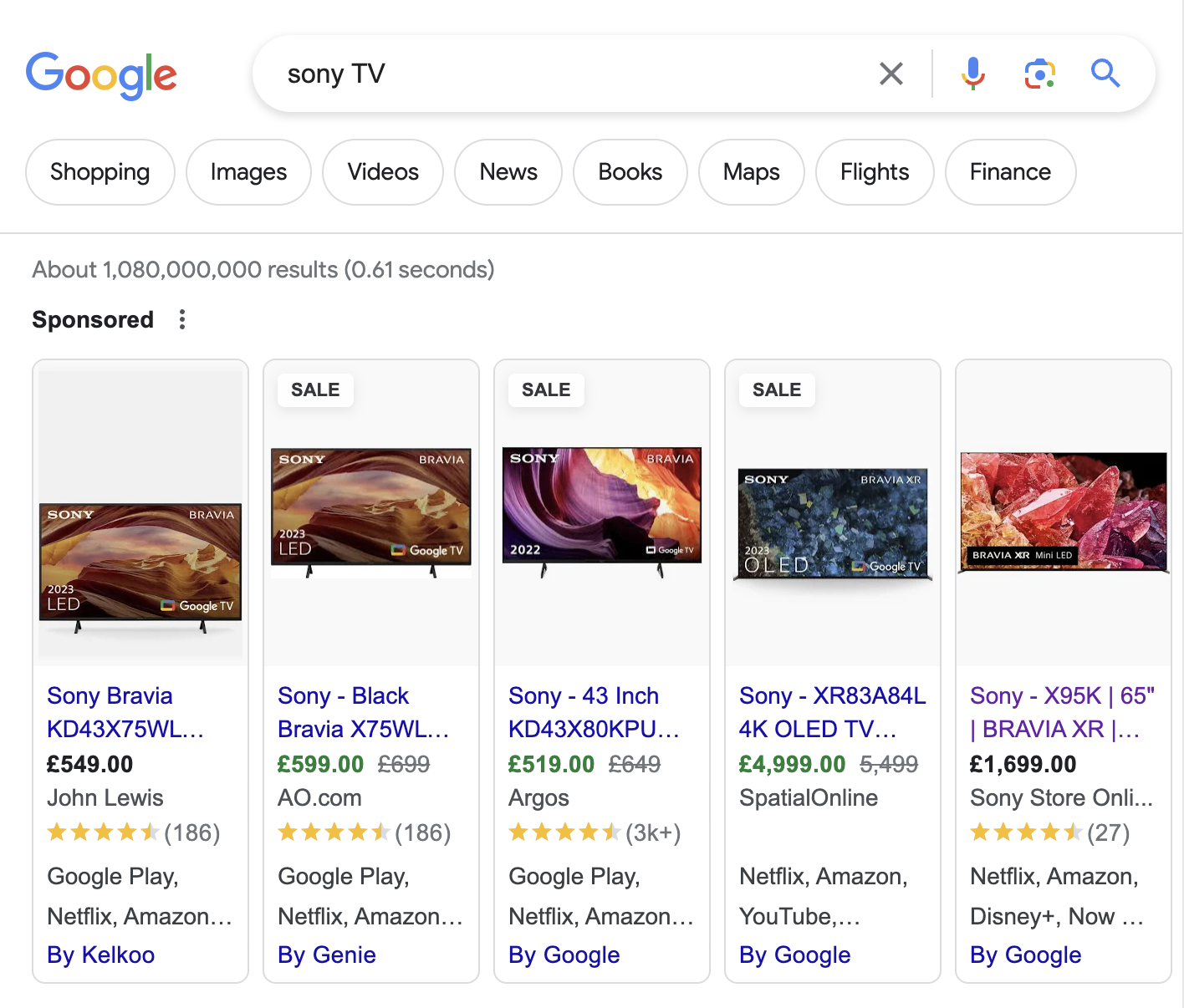
However, the prominence of major brands in this realm should encourage smaller brands and retailers to dive into the world of Product Listing Ads. Here's why:
An Equitable Playing Field: The dynamics of Product Listing Ads create an equitable playing field where size isn't the sole determinant of success. Unlike other advertising avenues, the market determines the cost of traffic through bids on ad clicks at the time of the search. This means that regardless of the brand's magnitude, the ad format remains restricted, creating an environment where a well-crafted strategy can compete with industry giants.
Focusing on Strategy Over Size: In this arena, strategic prowess outweighs brand size. A thoughtful and comprehensive strategy can help smaller brands discover their niche amidst the giants. The secret lies in understanding your target audience, optimising product data, employing effective keyword selection, and fine-tuning your bids to maximise efficiency. With these elements aligned, even modest-sized retailers can secure a significant share of the spotlight.
Navigating the Ad Format Limitations: The standardised format of Product Listing Ads presents challenges and opportunities. While it might seem limiting, it levels the playing field, ensuring that each ad's impact rests primarily on its relevance to user intent and needs. Smaller brands can use this to their advantage by focusing on product attributes that resonate with their target audience, capturing attention and driving conversions.
Product Listing Ads provide an arena where strategy, precision, and relevance reign supreme. While significant brands participate, their presence is within the opportunities for smaller players. The key to success lies in crafting a compelling strategy that resonates with your audience, thus enabling even the most modest brands to thrive in Product Listing Ads.
Emerging Trends and Future Insights of Product Listing Ads
The landscape of Product Listing Ads (PLAs) is in a perpetual state of evolution, driven by technological advancements, shifting algorithms, and emerging platforms. As we gaze into the future of PLAs, several trends and insights come to light that promise to shape how brands engage with audiences and promote their products.
The Dynamic Realm of Google's Machine Learning
Google continues to redefine the advertising landscape through its machine learning technologies, and this dynamic is evident in its latest offering: Performance Max campaigns. These campaigns leverage machine learning algorithms to optimise campaigns across various Google networks, transcending the boundaries of traditional PLA formats.
By automating campaigns and expanding ad reach, Performance Max campaigns are poised to revolutionise how advertisers harness the power of PLAs.
Merchant Center Next: Pioneering Convenience
Google's commitment to innovation is evident in Merchant Center Next—a significant update to the existing Merchant Center. This update introduces simplified interfaces and streamlined methods for importing product data, mitigating the technical complexities that sometimes hinder the seamless import of products. This move aligns with Google's dedication to democratising access to PLAs, allowing brands of all sizes to navigate the landscape with agility.
Mentioning our blog post 'Demystifying Merchant Center Next: A Guide To The Future of Product Listing Ads' offers readers an in-depth exploration of this emerging frontier.
Expanding Beyond Google
While Google remains a formidable force in the PLA arena, other platforms are also venturing into this realm. Bing, Facebook, and Amazon are carving their paths, introducing their versions of product ads. These platforms are poised to disrupt the landscape and provide brands with diversified avenues to connect with audiences.
Algorithmic Sophistication: The algorithms underpinning PLAs are becoming increasingly sophisticated. The ability to analyse user intent, predict purchasing behaviours, and tailor ad content accordingly opens new avenues for personalised engagement. Advertisers can anticipate a future where their PLAs are strategically positioned and hyper-targeted to individuals most likely to convert.
Augmented Reality and Visual Search: The fusion of augmented reality (AR) and PLAs presents an exciting prospect. Brands can empower users to visualise products within their physical spaces, allowing for immersive experiences that enhance decision-making.
Similarly, visual search, driven by advancements in image recognition technology, holds the potential to redefine how users interact with PLAs. Users might find the products they seek by capturing images, eliminating the need for textual queries. Google's image search within the Google Mobile app already offers features to search for products based on the selection of products it identifies within images.
The Continued Rise of Voice Search: Voice search is infiltrating every facet of digital engagement, and PLAs are no exception. With voice-activated assistants becoming integral to our lives, optimising PLAs for voice search queries is poised to be a game-changer. Brands that align their PLA strategies with the nuances of voice search stand to gain a competitive edge.
In this ever-evolving landscape, keeping a finger on the pulse of emerging trends is crucial. Adapting to these shifts ensures that brands can leverage the latest technological advancements to optimise their PLAs, delivering unparalleled experiences to their audiences. As we navigate the intersection of innovation and advertising, the future of Product Listing Ads looks promising and transformative.
Conclusion: Unleashing the Power of Product Listing Ads
In the digital advertising ecosystem, Product Listing Ads (PLAs) have emerged as potent tools for driving sales, enhancing visibility, and fostering brand growth. As we conclude our exploration of these dynamic ad formats, let's recap the key takeaways and offer some final tips and recommendations to guide you on your journey.
Key Takeaways: Mastering the Art of PLAs
Diverse Reach: PLAs transcend platforms, reaching audiences on Google, Bing, Facebook, Amazon, and more. This broad reach ensures your products are visible to potential customers wherever they are.
- - Visual Impact: Leveraging high-quality images and concise product information, PLAs captivate users at a glance, driving engagement and click-through rates.
- - Strategic Precision: Crafting well-optimised product titles, descriptions, and keywords is crucial. Ensuring your ads are relevant to user intent maximises their effectiveness.
- - Data Synchronisation: Keeping your product data updated across platforms is essential. Accurate pricing, stock information, and attributes provide a seamless user experience.
- - Strategic Targeting: Employing negative keywords, audience targeting, and retargeting helps refine your reach, connecting with audiences most likely to convert.
Final Tips and Recommendations: Embrace the Possibilities
- - Stay Informed: Continuously monitor the evolving landscape of PLAs. Stay updated on algorithm changes, new features, and emerging platforms to ensure your strategies remain effective.
- - Optimise Creatives: Invest in high-quality visuals that showcase your products. A compelling image can make a significant difference in attracting user attention.
- - Test and Refine: Regularly experiment with different ad formats, keywords, and targeting strategies. Analyse the results to refine your approach and enhance performance.
- - Embrace Automation: Take advantage of machine learning technologies offered by platforms like Google's Performance Max campaigns. Automation can streamline your campaigns and yield impressive results.
- - Leverage Insights: Utilise the data provided by ad platforms to gain insights into user behaviour and preferences. Use this information to tailor your campaigns for maximum impact.
Unlock Your Business Potential with PLAs
As you navigate the intricate digital advertising landscape, embracing Product Listing Ads can be a transformative step for your retail business. These ads offer a versatile and engaging way to connect with your target audience, driving sales and fostering growth. By optimising your product data, harnessing strategic targeting, and embracing emerging trends, you can unlock the full potential of PLAs and propel your brand towards success.

Book A Discovery Call
Looking for tailor-made PPC strategies? Our team is here to help you maximize your online store's potential. Book a discovery call with us for personalised insights and solutions.
Book Your Free ConsultationBook Your Call